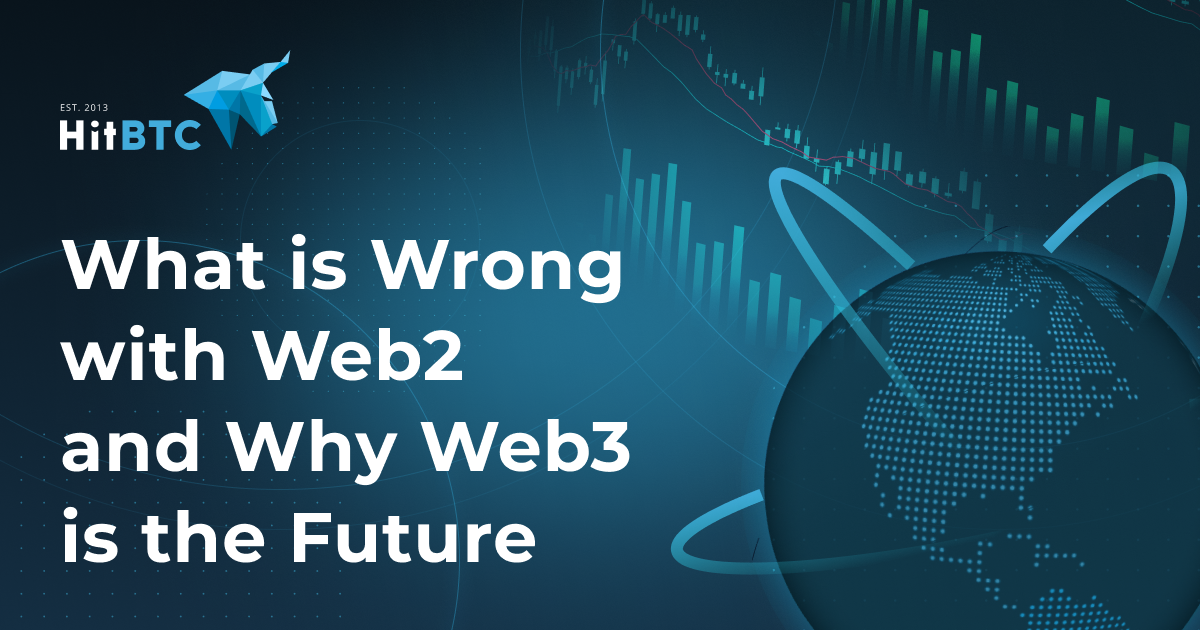What is Wrong with Web2 and Why Web3 is the Future

The first version of the internet, which allowed us to search and read information online, was groundbreaking yet imperfect. Web2, the internet as we know it today, came as way more resourceful and dynamic, but still limited.
On the surface, an average Web2 user might be happy with their experience, but once we dig a little deeper, a lot of issues arise. There is massive pressure on Web3, the latest global network iteration, to solve all the problems of the current internet, including data ownership and centralization.
In this piece, we will review Web2 limitations and take a look at what Web3 has to offer.
Web2: Alive But Not User-Centric
When Web2 took over from the original internet version, it enabled users to create and share their content. Starting as chatrooms and forums, social media turned into a big business. Today, an estimated 4.59 billion people around the world are using social networks for various reasons.
A few tech giants took control of this enormous market, providing necessary infrastructure and services in exchange for our data. Exploiting data for target advertising and marketing purposes is exceedingly profitable for Big Tech, while users settle for the bare minimum.
Another downside of Web2 is that it is not user-centric. Having to create multiple logins on different websites, followed by compromised passwords, as well as inefficient search results and irrelevant marketing – these are just a few examples.
Centralization is yet another inconvenience. In Web2, sending money online without involving a trusted third party is impossible. The same goes for data: every online interaction leads to your data being copied, which will eventually end up on data servers, depriving you of privacy.
On top of that, Web2 is all about censorship. Modern freedom of speech only goes so far – any social media platform can potentially block or restrict your content without explanation or a chance to rehabilitate.
The Web3 Promise
Currently in the making, Web3 promises to be more open, autonomous, and user-friendly. Accompanied by cutting-edge technologies like blockchain, AI, augmented reality, and virtual reality, it will cater to the user first.
In the new Web3-powered reality, personalized services and effective communication will pair with personal data ownership. Blockchain tech will ensure data protection by keeping it distributed across a network of people and using a consensus-based mechanism to check the validity of any changes.
In Web3, DAOs are likely to become the preferred governance system, allowing users to get more involved in the operational processes and the development of the ecosystems. The DAO model is set up to enable real democracy, as opposed to one-man leadership.
On top of that, anyone will be able to benefit from the permissionless nature of Web3 and join a network without asking for any authorization. Web3 networks and ecosystems are ultimately inclusive, with services open to everybody. Similar to the way it is organized in open-source projects, Web3 users can also offer their skills and expertise to improve the work of the network, and get rewarded for their contributions.
Decentralized digital identity – a web address that people can own and control – will become an advanced way to protect privacy and improve user experience. For instance, a decentralized ID that contains all your personal data, can be used on different platforms and share only certain information necessary for this particular case. This way, you will not overshare while providing authentication.
The perspectives are brighter than ever, but why are we not there yet?
The Challenge
Although numerous companies are currently developing Web3-related products and services, the new era of the internet is still a work in progress. Before we get to enjoy everything the decentralized web has to offer, we have to face a few challenges.
Apart from the enormous cost and effort that needs to be put into building an entirely new internet model, developers will have to deal with inconsistent data across the web and figure out the way to fix the incongruities.
Chances are, the transition to Web3 is not going to be seamless for everyone. While some users will hold on to Web2 as something they are already used to, others will not have the means to buy newer devices supporting the work of Web3 apps.
On the other hand, since the majority of Web3 processes are happening backstage, regular users might not even notice the change. The decentralized editions of the centralized apps we are using today will slowly pave their way into our everyday life, marking the rise of the new internet era.
The Bottom Line
The current version of the internet is outdated. It was created to benefit big corporations, which results in poor user experience. Web3 is all about decentralization, community governance, owning your personal data, and the next level of comfort. Although it will take a while for the current system will be replaced, you can already make good use of decentralized apps and even help them build faster.
For instance, you can support your favorite project by purchasing their tokens and staking them if that is available. Investing in tech is a common practice that often proves to pay off. Should you decide to give it a go, HitBTC is one of the most secure exchanges that offers a large variety of crypto coins and tokens to choose from.
Сrypto wallet App
The HitBTC crypto wallet is a free and simple solution for beginners.
Fees and Limits update
We have recently updated our Fees and Limits. For the latest updates, please visit the Fees and Limits section on our website here.
HitBTC Mobile App
Do not forget that you can trade on our platform from your mobile device. Start today by downloading the HitBTC App on Android and iOS.
